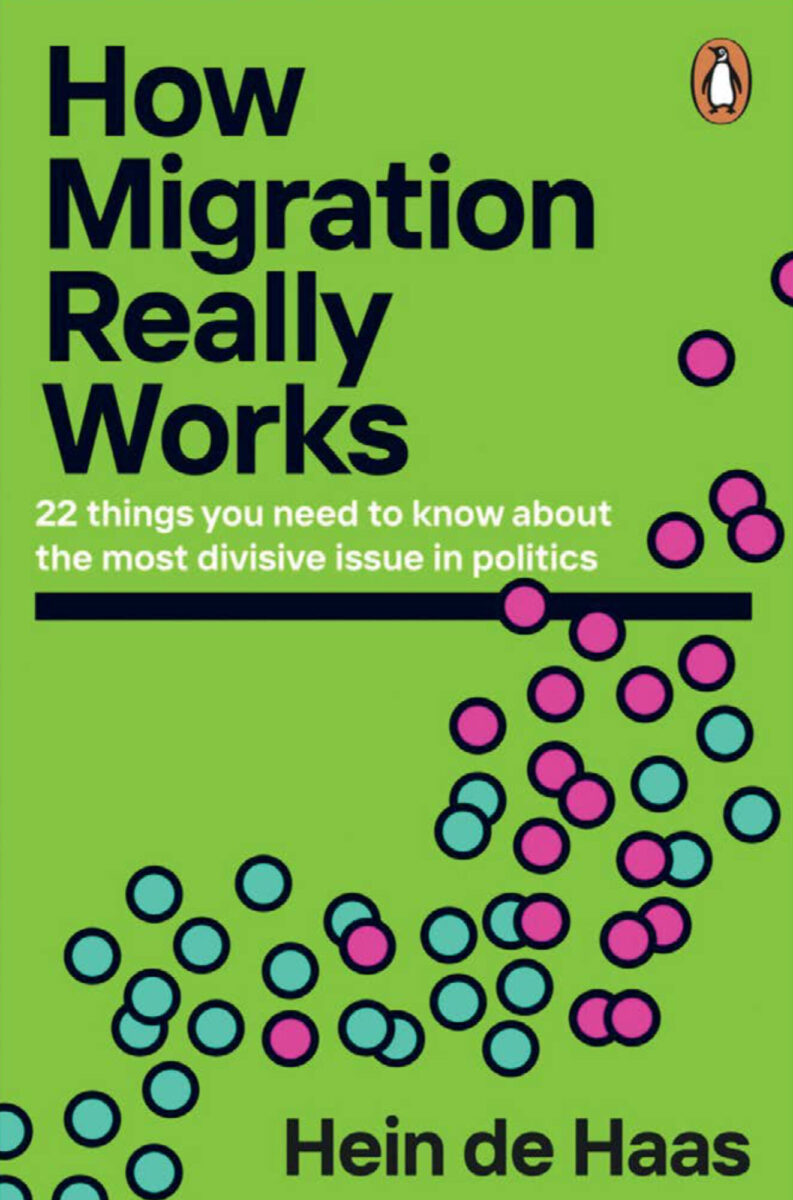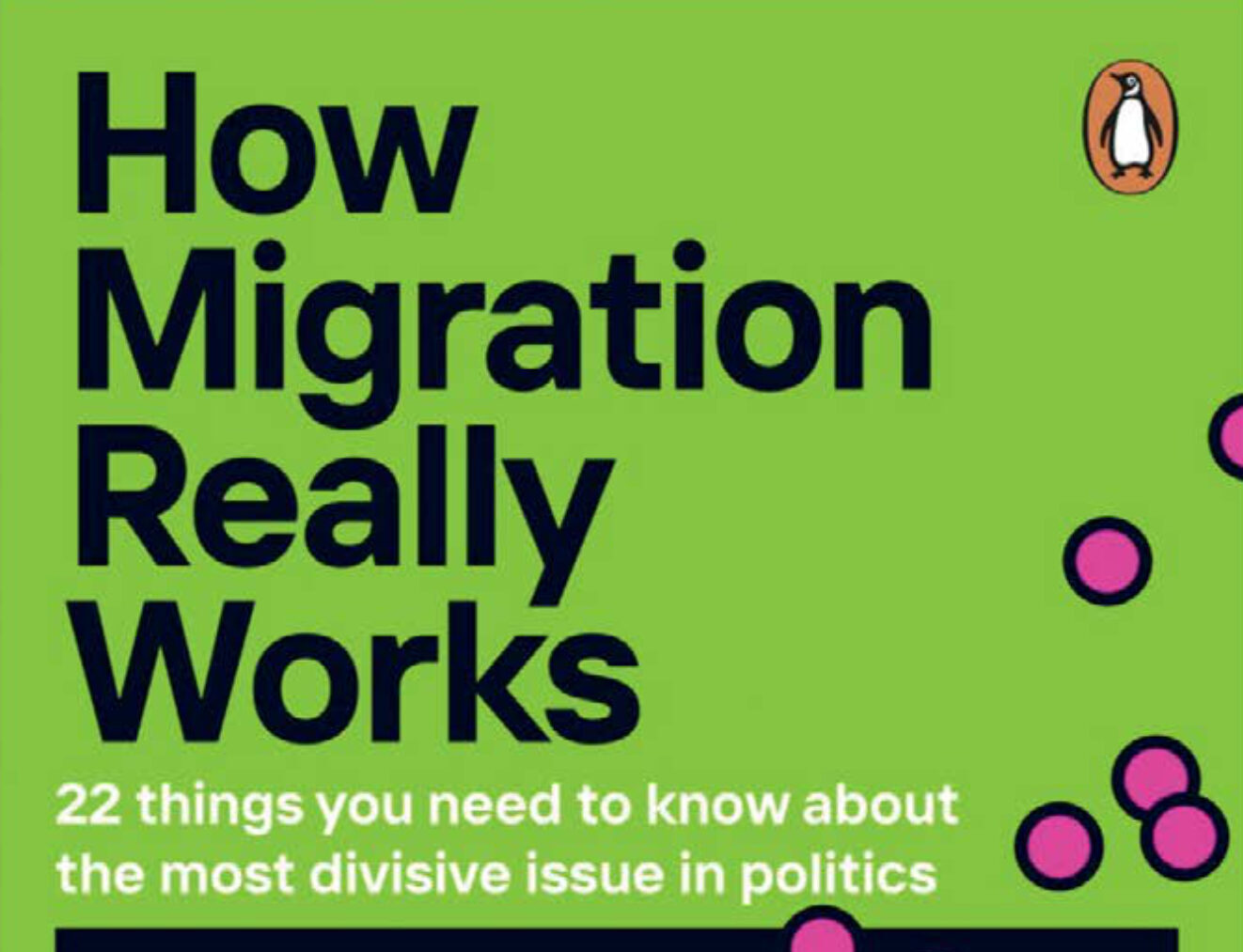Main content
At the time of writing my review of Hein de Haas’ study on migration,[1] I found myself in Bangladesh working on an interuniversity programme on climate change and green skills education and training. It was an interesting context for reviewing de Haas’ account on migration, as Bangladesh ranks as the sixth-largest migrant population worldwide, and is one of the largest remittance-receiving countries.[2]
Working on the production of this edition of MTb on Migrants and Health and the symposium Care for Newcomers[3] inspired me to read de Haas’ book in the first place. The presentations and discussions at the symposium made it more than clear to me that, in order to define and respond to health needs of migrants, it is good to clarify who we are talking about as well as the many misconceptions that surround migrants and migration matters in the current debate and public understanding.[4]

How Migration Really Works
22 things you need to know about the most divisive issue in politics
English
Paperback 9780241998779
08 August 2024 464 pages
Political suicide
The book How migration really works, 22 things you need to know about the most divisive issue in politics delivers on its promise in many ways. Thirty years of social science research on migration is skilfully presented in this impressive book on trends and patterns of global human migration. In his quest to dispel persistent left- and right-wing migration myths, de Haas presents an overwhelming amount of data, facts, figures and essential information to discuss the current myths surrounding the migration debate. He wrote the book with a great sense of urgency as, despite the many lectures he delivered and the many debates he participated in, he realised that speaking truth to power was simply not enough to improve the tone and quality of the debate. Often, high-ranking policymakers complimented him on the fantastic presentation he gave, but reassured him that putting his advice into practices would of course be political suicide.
He wrote the book to give the general reader tools to engage in a more informed debate and to challenge the visions of (Western) politicians on the migration problem. The book does not pretend to give an ideological perspective on migration, as de Haas mentions “if it was a solvable problem – or the contrary – a solution to a problem”. Rather, migration is here; it is an intrinsic and inseparable part of the broader social, economic and cultural changes in societies and in the world in general – changes that will have an impact, sometimes for the good and sometimes downright detrimental – but inevitable changes that cannot be ignored or wished away. We had better take an informed look at the nature and causes of this phenomenon and change the framing of the debate.
Some statistics
Two easy to memorise facts stand out. First, migration is as old as mankind, and secondly, international migration has remained stable at around 3% of the world’s population. This means that 97% live in their country of origin. A remarkable figure, so sees De Haan, given the enormous inequality in the world. Roughly around one tenth of all migrants are considered refugees, and most of them find shelter in a neighbouring country. Since the 1950s, the percentage of refugees has fluctuated between 0.1 and 0.35 of the world’s population. Also, statistics show that while migration patterns have changed over the years, the overall numbers have not dramatically increased. Obviously, what did change were people’s motivations to migrate, such as during the heydays of the trans-Atlantic migration when millions of Europeans left the ‘Old World’ to embark on a new adventure in The United States, Canada, Brazil, and Australia. Or the waves of mass-migration in the period when European imperialism reigned and many European soldiers, colonists, missionaries, administrators and business people settled in the colonies. Or the insatiable quest for a labour force driven by European imperialism and industrialisation. The book carefully compiles these statistics and presents each of the myths in a similar way: first introducing the misconceptions, such as: Illegal migration is getting out of hand (Myth 2) – followed by a section on How it really works.
So how does it work in the case of bangladesh?
Migration as a desperate flight from misery: the sixth myth that Hein de Haas challenges in his book. Could that be the case for the many Bangladeshis who ‘flee’ their home country for greener pastures elsewhere? At first glance, in view of the public image that people may have of Bangladesh (poor, unstable, high inequality, high levels of corruption), one could believe that this indeed is the drive of many. On the other hand – as with the other myths that de Haas carefully dismantles with a wealth of data, statistics and analysis – first glances are often misleading. According to World Bank data, the country was able to reach a lower-middle income status while coming from being one of the poorest nations on earth after gaining its independence in 1971, and was also able to vastly improve its human development indicators.[5]
“The picture that politicians and journalists paint of migration from poor countries is often steeped in stereotypes about poverty and misery in ‘the third world’. However, the data belie the stereotypical view that migration from developing countries is based on irrational dreams about life abroad. Although many migrants face hardships, are often exploited and get disappointed at times, the majority still believe that leaving is a better option than staying. The money that migrants send home is an important source of income for families and communities in countries of origin”. More than often, as he continues, it is the result of people’s rational decision to simply want to better their (and their family’s) living conditions, the family income, or young people’s interest in education and career opportunities abroad. Seen from this angle, migration can become a gamechanger at the individual and societal level – and even more effective than development aid. Figures also underlie this, as in 2020 global remittances surpassed the level of development aid ($193 billion) by some 2.6 times.[6] For Bangladesh this amounts to almost $22.1 billion (2021), making it the seventh highest recipient of remittances in the world, and the third highest recipient of remittances in South Asia.[7] As such, remittances are a more stable factor in the development of a nation than relying on international development aid. This is food for thought given the trend of cutting rigorously in Western spending on development aid, like in the Netherlands where recent government plans involve high cuts in development aid.[8]
In more than one way, Bangladesh is an interesting case for reflections on migration. While many Bangladeshis leave the country (roughly 4.4% of the total population of 170 million population is residing overseas), at the same time, the country is experiencing rapid urbanisation and internal migration, and is hosting one of the largest refugee populations in the world: the approximately one million Rohingya from Myanmar in makeshift settlements around Cox’s Bazar.[9] The vast majority of migrants from Bangladesh are so-called ‘regular’ labour migrants to countries in the Gulf (a popular destination since the 1970s oil boom), and to Malaysia, Indonesia, and Australia, and only in more recent years to Europe and North America.[10] In spite of what politicians want us to believe. (see the chapter on Myth number seven: We do not need labour migrants), many of these labour migrants are more than welcome in the recipient countries. Making the demand for labour one of the major drivers for international migration. Migrants often fill the 3-D vacancies that are hard to fill these days: the dirty, dangerous and demeaning jobs. They may not be wanted but are by default, indispensable and serve as the oil in the neo-liberal system.
Back to migration and health, moving forwards
Meanwhile, back in the Netherlands, the Dutch government continues to look for ways to frame the migrant situation in the country as a national crisis. In fact, we still see all the myths that are debunked in the book continue to feature as ‘truth’ in the media and in the policy intentions of the politicians. The book provides sufficient ammunition to counter all of this.
But what should and can we do, and how? These are also questions which de Haas addresses in his final chapter. As far as he is concerned, the answer depends on the kind of society we want to live in. Unfortunately, this debate is difficult to hold with icy political winds blowing (read: anti migration winds), in a highly polarised context, and not only in the Netherlands. In a way, de Haas concludes with hope. Rather than focusing on what went wrong and where policies have failed, we should acknowledge the progress that has been made and the reality we are in. Like it or not, de facto we have accepted that we have become immigration countries. And while many European countries are working on a stricter migration policy, the Spanish government recently presented a series of reforms to their migration policy, wanting to make it easier for migrants to come and work in Spain – not only because of humanitarian reasons, but mainly for economic and demographic reasons.[11] They clearly accepted what De Haas refers to as the elephant in the room in the migration debate – our persistent demand for labour. Meanwhile Denmark has also taken a different path and is revisiting its migration policies. They too realised the counterproductive results of their highly restrictive migration policies, as not only unwanted foreigners failed to come but also the wanted ones (i.e. the much-needed labour migrants and students). A U-turn was needed.[12]
Let these U-turns be an inspiration. And in the meantime, countries are held to fulfil their obligations on respecting ‘the right to health’ and ‘universal access to health for all’, without exceptions, including the newcomers, the not so recent newcomers, and people without proper legal documents. The symposium Care for Newcomers in the Netherlands was a valuable step towards making this happen. To be continued.
Also available in Dutch:
Hoe migratie echt werkt
Het ware verhaal over migratie aan de hand van 22 mythen
Nederlands, Paperback, 9789000386857
21 september 2023, 520 pagina’s
References
- Haas H de (2023). How migration really works. 22 things you need to know about the most divisive issue in politics
- Duque M.C (2024). Climate Change in Bangladesh Shapes Internal Migration and Movement to India. In: Migration Policy Institute.https://www.migrationpolicy.org/article/bangladesh-india-climate-migration#:~:text=Bangladesh%20is%20the%20origin%20of,Organization%20for%20Migration%20(IOM)
- Held on the 9th of October, organised by NVTG, KCGH and OIGT. For more information: https://www.kcgh.nl/nieuws/succesvolle-eerste-editie-van-het-symposium-zorg-voor-nieuwkomers-en-lancering-van-de-handout-zorg-voor-nieuwkomers-in-beeld (in Dutch)
- Definitions (Haas H de, 2023): a migrant is someone who lives in a place or country other than the place where he or she was born (this includes all citizens in a country that were born abroad, not including the children or grandchildren of migrants, as they are 2nd or 3rd generations of migrants – not having migrated themselves). Within this broad category there are various types of migrants: labour migrants, family migrants, study migrants, business migrants, forced migrants or refugees. The category of forced migrants mainly includes people who have had to change their place of residence due to violence or persecution in their country of origin. Within the group of forced migrants there is an important legal distinction between asylum seekers and refugees. An asylum seeker claims refugee status and is still awaiting a decision on whether or not he or she will be recognized as a refugee. People who flee their native region but remain within the borders of their country are generally referred to as internally displaced persons.
- https://www.worldbank.org/en/country/bangladesh/overview
- Haas H de (2023)
- https://mofa.gov.bd/site/press_release/623cdb86-6490-4d63-8297-5e1e4a528b9c#:~:text=Deputy%20High%20Commissioner%20highlighted%20that,to%20Bangladesh%20and%20also%20to
- https://nos.nl/artikel/2544059-minister-klever-voor-ontwikkelingshulp-bezuinigt-1-miljard-op-ngo-s and https://www.government.nl/latest/news/2024/09/18/budget-day-2024-lower-cutbacks-to-embassies-major-retrenchment-on-development-aid (both in Dutch)
- Beyond dichotomies: Bangladesh’s complex migration landscape, essay By Ashraful Azad1 & Jennifer Vallentine published in: Horwood, C. & Frouws, B. (Eds.). (2023). Mixed Migration Review 2023. Highlights. Interviews. Essays. Data. Geneva: Mixed Migration Centre. Available at: https://mixedmigration.org/mixed-migration-review-2023/
- Idem.
- https://www.nrc.nl/nieuws/2024/10/10/spaanse-premier-zonder-extra-immigranten-stort-onze-economie-in-a4868953?t=1728632944 (in Dutch)
- https://www.nrc.nl/nieuws/2024/10/12/waarom-denemarken-studenten-in-afrika-ronselt-a4869099 (in Dutch)



















































